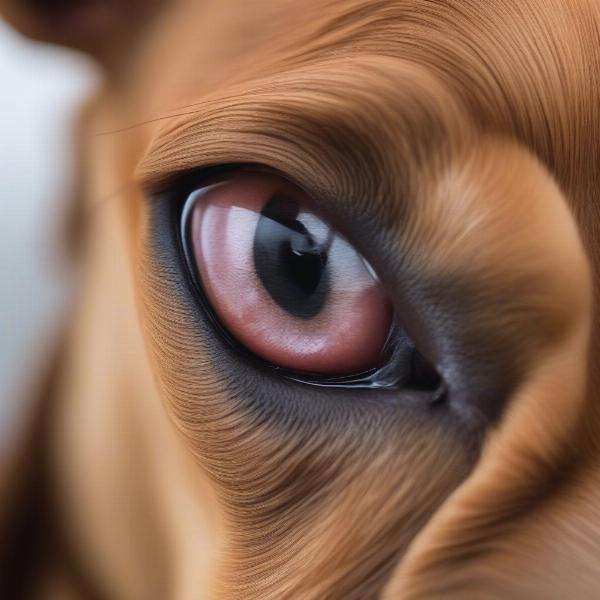Ear infections are a common problem in dogs, often causing discomfort and distress. Finding the best ear drops for your furry friend can be challenging with so many options available. This guide provides a comprehensive overview of choosing and using ear drops effectively, addressing various ear-related issues in dogs.
Understanding Canine Ear Infections
Before selecting ear drops, it’s crucial to understand the common causes of ear infections in dogs. Factors like allergies, bacteria, yeast, ear mites, and even excessive moisture can contribute to these infections. Symptoms can include redness, swelling, discharge, head shaking, and scratching at the ears.
 Dog Ear Infection Symptoms
Dog Ear Infection Symptoms
Choosing the Right Ear Drops
Several types of ear drops are available, each targeting specific issues. Some common ingredients include antibiotics to combat bacterial infections, antifungals for yeast infections, and anti-inflammatory agents to reduce swelling and pain.
Always consult your veterinarian before using any ear drops. They can accurately diagnose the cause of your dog’s ear problem and prescribe the most effective treatment. Never use human ear drops on your dog, as they can cause further complications.
Types of Ear Drops for Dogs
- Antibacterial Ear Drops: These target bacterial infections, often characterized by a foul-smelling discharge.
- Antifungal Ear Drops: These combat yeast infections, which can cause a dark, waxy discharge.
- Anti-inflammatory Ear Drops: These help reduce inflammation, itching, and discomfort associated with ear infections.
- Ear Mite Treatment Drops: Designed to eliminate ear mites, these drops often require multiple applications over several weeks.
- Ear Cleaning Solutions: While not strictly medication, these solutions help remove debris and excess wax, supporting the effectiveness of medicated drops.
How to Administer Ear Drops
Administering ear drops correctly is crucial for effective treatment. Follow these steps:
- Gently clean your dog’s ear with a veterinarian-approved ear cleaning solution.
- Warm the ear drops to body temperature by holding the bottle in your hand for a few minutes.
- Hold your dog’s ear flap up and carefully insert the prescribed number of drops into the ear canal.
- Gently massage the base of the ear to distribute the drops.
- Allow your dog to shake their head, which helps spread the medication further.
- Repeat the process for the other ear if necessary.
Preventing Ear Infections
Regular ear cleaning and proper grooming can help prevent ear infections. Keep your dog’s ears dry, especially after swimming or bathing. my dogs ear is bleeding Discuss any concerns about your dog’s ear health with your veterinarian.
What If My Dog’s Ear is Still Bothering Them?
If your dog’s ear infection persists or worsens despite using ear drops, consult your veterinarian immediately. They may need to adjust the medication or explore alternative treatment options.
Conclusion
Finding the best ear drops for dogs requires a proper diagnosis and veterinary guidance. By understanding the causes and types of ear infections, you can work with your veterinarian to select the most appropriate treatment and provide your furry friend with the relief they need. Remember to best ear drops for dogs itchy ears always consult your veterinarian for accurate diagnosis and treatment recommendations.
FAQ
- How often should I clean my dog’s ears? The frequency of ear cleaning depends on your dog’s breed and individual needs. Consult your veterinarian for personalized advice.
- Can I use home remedies for dog ear infections? It’s best to avoid home remedies without veterinary approval, as they can sometimes worsen the condition.
- What are the signs of a severe ear infection? Signs of a severe ear infection can include bleeding from the ear, loss of balance, or facial paralysis. Seek immediate veterinary care if you observe these symptoms.
- Are some dog breeds more prone to ear infections? Yes, dogs with floppy ears or hairy ear canals are generally more susceptible to ear infections.
- How can I prevent ear infections in my dog? Regular ear cleaning, proper drying after swimming or bathing, and addressing underlying allergies can help prevent ear infections.
Related Articles
ILM Dog is your trusted resource for comprehensive dog care information. We offer expert advice on breed selection, health, training, nutrition, grooming, and much more. Whether you’re a new dog owner or a seasoned expert, ILM Dog provides valuable insights to help you provide the best care for your canine companion. For personalized guidance on your dog’s health and well-being, contact us today at [email protected] or call +44 20-3965-8624. Visit us online at ILM Dog.